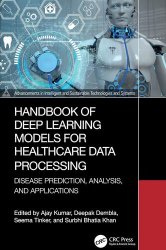Handbook of Deep Learning Models for Healthcare Data Processing
- Добавил: literator
- Дата: 29-06-2025, 17:26
- Комментариев: 0
 Название: Handbook of Deep Learning Models for Healthcare Data Processing: Disease Prediction, Analysis, and Applications
Название: Handbook of Deep Learning Models for Healthcare Data Processing: Disease Prediction, Analysis, and ApplicationsАвтор: Ajay Kumar, Deepak Dembla, Seema Tinker, Surbhi Bhatia Khan
Издательство: CRC Press
Серия: Advancements in Intelligent and Sustainable Technologies and Systems
Год: 2026
Страниц: 310
Язык: английский
Формат: epub (true)
Размер: 10.1 MB
In recent years, Deep Learning has shown great potential in transforming various fields including healthcare. With the abundance of healthcare data being generated every day, there is a pressing need to develop efficient algorithms that can process and analyze this data to improve patient care and treatment outcomes.
Handbook of Deep Learning Models for Healthcare Data Processing: Disease Prediction, Analysis, and Applications covers a wide range of Deep Learning models, techniques, and applications in healthcare data processing, analysis, and disease prediction, providing a comprehensive overview of the field. It focuses on the practical application of Deep Learning models in healthcare and offers step-by-step instructions for building and deploying models and using real-world examples. The handbook discusses the potential future applications of Deep Learning models in healthcare, such as precision medicine, personalized treatment, and clinical decision support. It also addresses the ethical considerations associated with the use of Deep Learning models in healthcare, such as privacy, security, and bias. It provides technical details on Deep Learning models, including their architecture, training methods, and optimization techniques, making it useful for data scientists and researchers.
Recent advancements in AI and DL have led to the development of language models that are incredibly smart and can understand language almost like humans do. These models, known as large language models (LLMs), have become quite popular because they’re good at processing and understanding language. They’re trained on huge amounts of text data and can generate responses that sound natural and make sense when you ask them questions. LLMs can achieve general-purpose language generation and other natural language processing tasks such as classification. LLMs are built using many layers of neural networks, and a key component in these models is something called transformers. Transformers are special tools that help the model understand language better; they work by paying attention to different words in a sentence and figuring out how they relate to each other. LLMs learn in two main steps: pretraining and fine tuning. In the pretraining step, the model learns from extensive amounts of different text sources, like books and articles, to understand how words fit together; it gets good at predicting what words might come next in a sentence based on the ones before, training to learn how language works and what words often go together. When the model reads a sentence, it uses self-attention mechanisms to decide which words are important and how they fit together. This helps the model understand the context of the sentence and what it’s trying to say. Then, in the fine-tuning step, the model gets more specialized training on specific tasks or topics.
Written to be a comprehensive guide for healthcare professionals, researchers, and data analysts, this handbook is an essential need for those who are interested in using Deep Learning models to analyze and process healthcare data. It is also suitable for those who have a basic understanding of Machine Learning and want to learn more about the latest advancements in Deep Learning in healthcare.
Contents:
Скачать Handbook of Deep Learning Models for Healthcare Data Processing
[related-news] [/related-news]
Внимание
Уважаемый посетитель, Вы зашли на сайт как незарегистрированный пользователь.
Мы рекомендуем Вам зарегистрироваться либо войти на сайт под своим именем.
Уважаемый посетитель, Вы зашли на сайт как незарегистрированный пользователь.
Мы рекомендуем Вам зарегистрироваться либо войти на сайт под своим именем.

